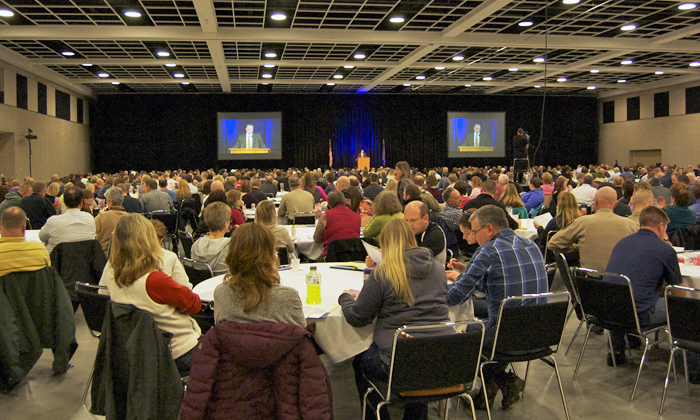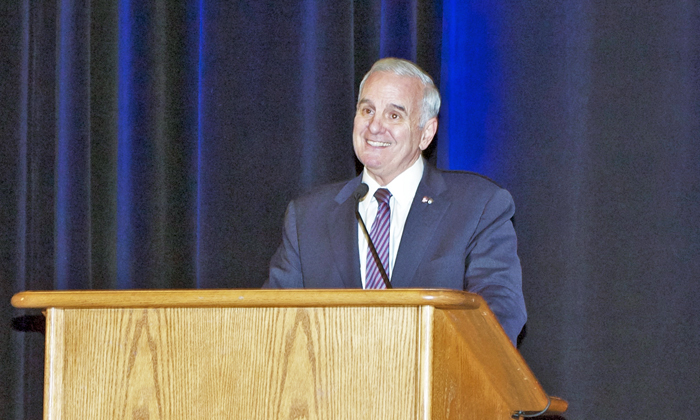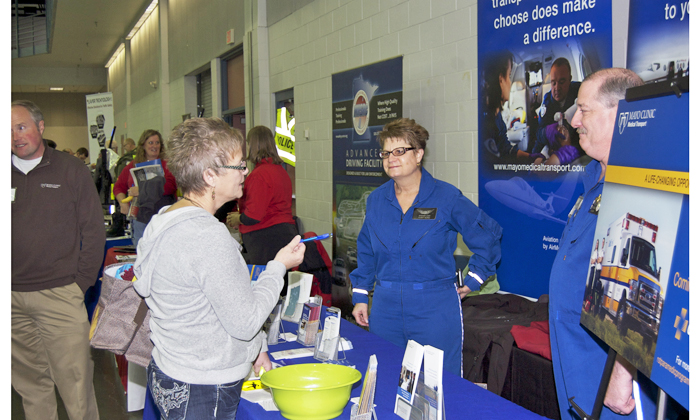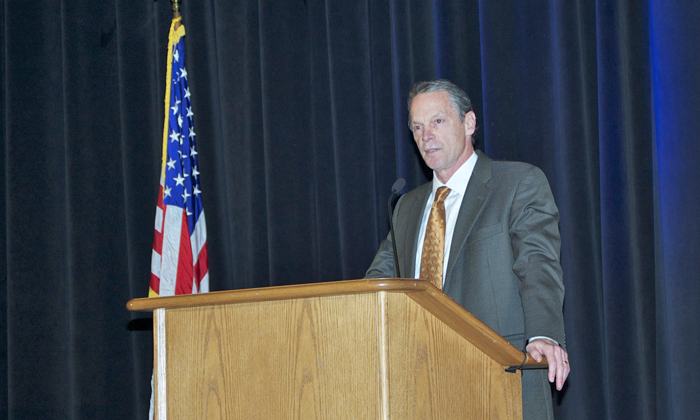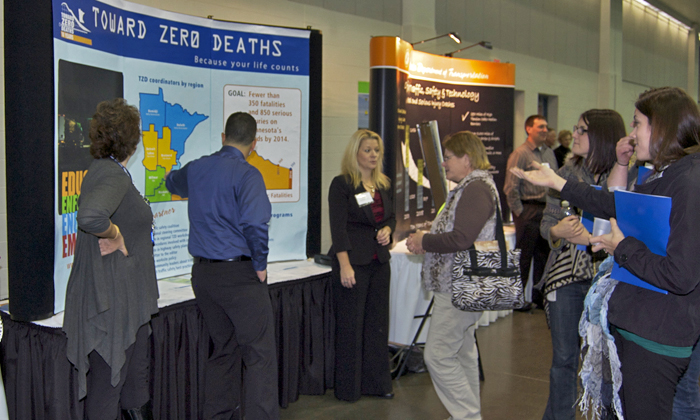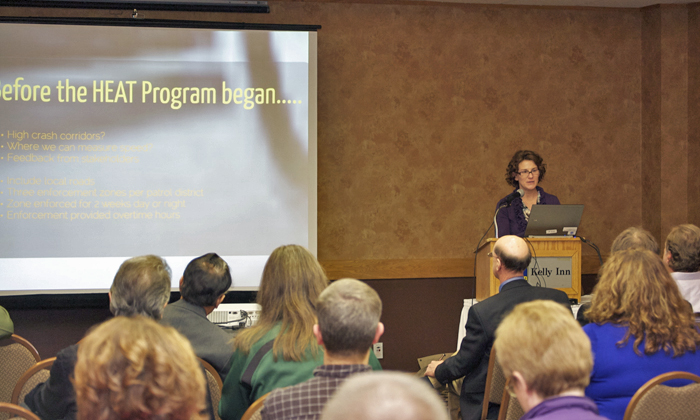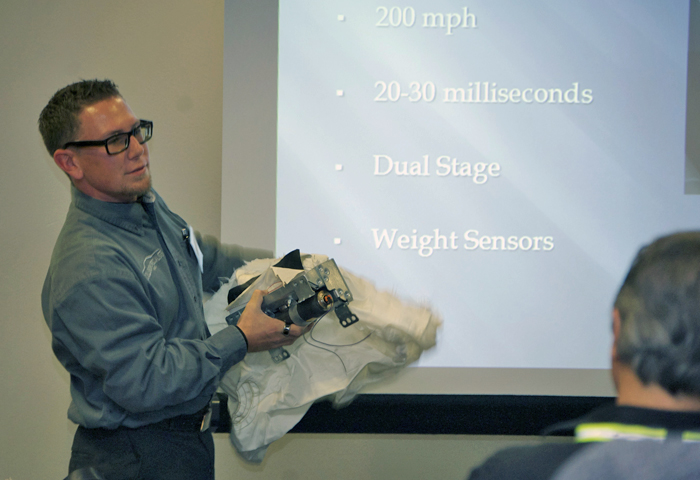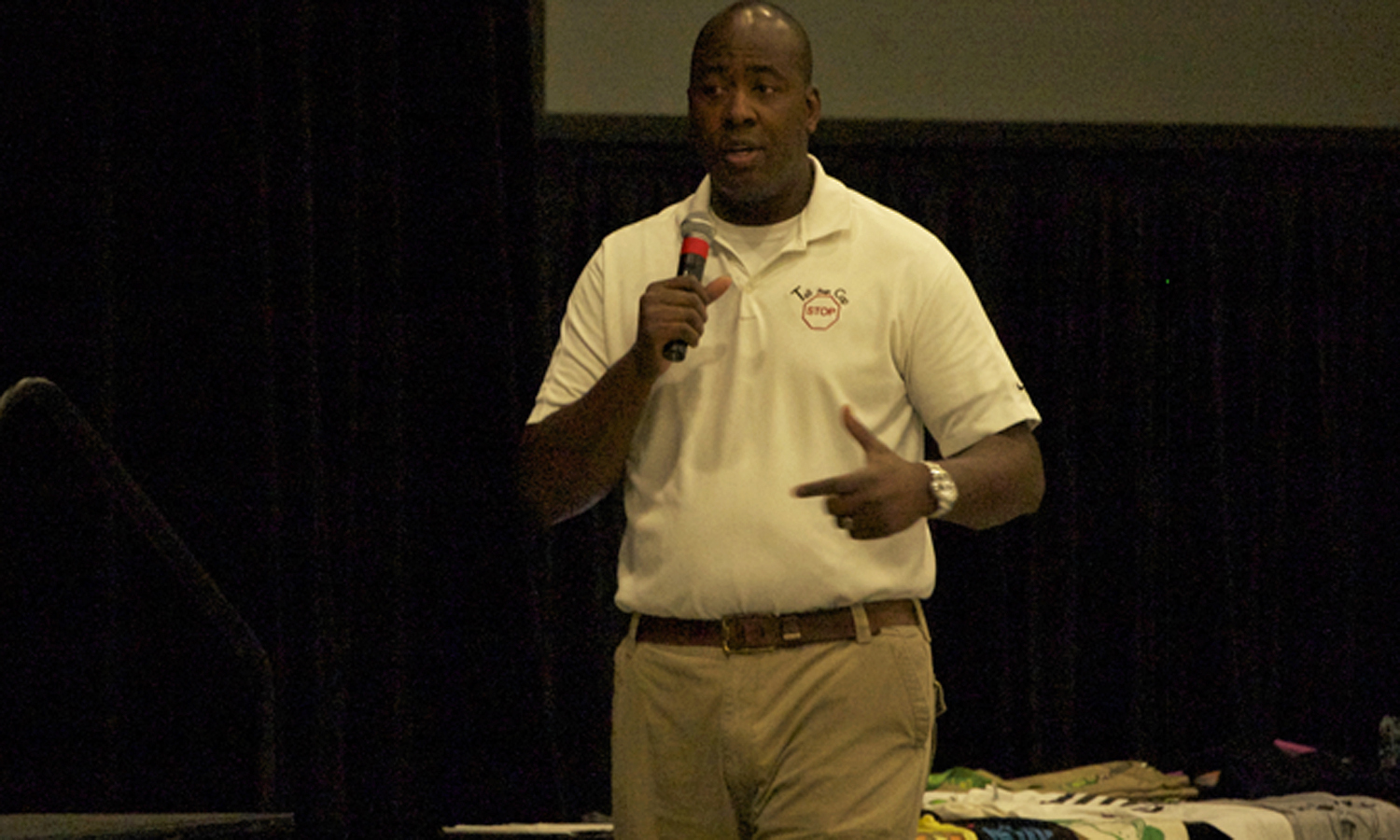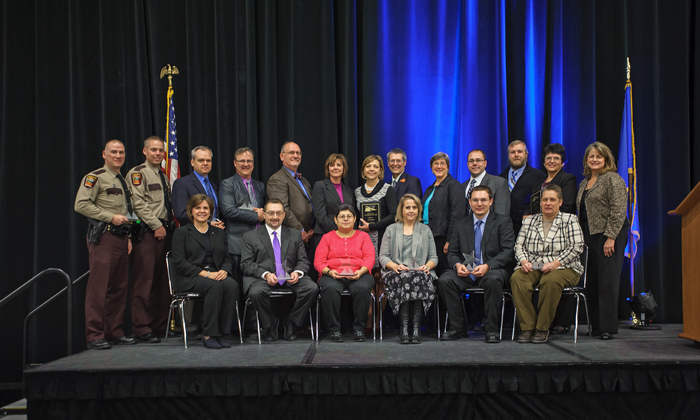- What is TZD?
- TZD Initiatives in MN
- Events
- News
- Resources
- Aggressive Driving
- Bicycling & Pedestrian Safety
- Child Passenger Safety
- Distracted Driving
- Education
- Emergency Medical & Trauma Services
- Enforcement
- Engineering
- Impaired Driving
- Intersection Safety
- Lane Departure
- Older Drivers
- Rail Crossing Safety
- Seat Belt Use
- Statistics
- Traffic Safety Legislation
- Videos
- Younger Drivers
2013 Toward Zero Deaths Conference
November 14-15, 2013
St. Cloud, Minnesota
Materials
- Final Program (284 KB PDF)
Presentations
Welcome and Opening Remarks
Plenary Session: The Court's Role in Traffic Safety
Effective intervention with addicted drivers should be treatment-based and coupled with strong and thoughtful supervision. Judge Floerke founded a DWI Court for high-risk/high-need offenders six years ago and has seen great success. His team is broadly applying the principles it has learned to more and more DWI offenders, aiming to stop the addiction cycle before it leads to repeated arrests and harm. Judge Floerke was joined by a graduate from the DWI Court who spoke about how this initiative helped the individual recover and succeed.
Plenary Session: Toward Zero Fatalities—Volvo Vision 2020 and Swedish Vision Zero
Swedish society has a long tradition of having traffic safety as one of its key priorities. This presentation discussed several success factors in developing this tradition, including the Swedish Parliament’s "Vision Zero," which states that no other target than zero fatalities is acceptable; Volvo Cars' "Vision 2020," which states that no occupant is to be killed or seriously injured in a new Volvo by 2020; and a cooperation agreement between Volvo Cars and the Swedish Traffic Administration put in place to optimize ways to shape the transportation system.
Better Data, Better Decisions with New Crash Records System
Crash reporting is the heart of data-driven decision making in traffic safety. To make the best decisions, data must be complete, accurate, and timely. After careful consideration of resources and feasibility, the Minnesota Department of Public Safety decided it is in the best interest of all stakeholders to replace the current legacy crash records system rather than seek to make enhancements to an antiquated system that may be unable to sustain the changes. This presentation included a project overview, update on work to date, and next steps, including data user involvement.
- Kathleen Haney, Office of Traffic Safety, Minnesota Department of Public Safety (3.7MB PDF)
- Nathan Drews, Office of Traffic, Safety, and Technology, Minnesota Department of Transportation (1.4MB PDF)
Distracted Driving: Traditional and Non-Traditional
Peace officers see firsthand the results of distracted driving and the carnage it can leave behind. This session covered traditional and non-traditional methods of detecting the distracted driver and the benefits to public safety when enforcement action is initiated.
- Lt. Brian Reu and Sgt. Paul Davis, Minnesota State Patrol, Minnesota Department of Public Safety (847KB PDF)
Surviving the Crash: The Role of the Statewide Trauma System
The Minnesota Statewide Trauma System sets forth priorities to promote the best chance of survival of traumatic injuries, including motor vehicle crashes. EMS has an integral role along with law enforcement, fire, maintenance, and dispatch to utilize the essential concepts outlined in the protocol. This session reinforced the theme and implications of successful usage of the system.
Breaking News from the Research Desk! Findings from Minnesota Traffic Safety Studies
So what can we learn from Minnesota's traffic crash data? Participants learned about recent traffic safety studies (including weather impact and roadway lighting at intersections) that were conducted using Minnesota crash data and how this information can be better utilized.
- Shawn DeVinny , National Oceanic and Atmospheric Administration (1.6MB PDF)
- John Bullough, Rensselaer Polytechnic Institute (4MB PDF)
DRE Program Updates
This session discussed Drug Recognition Evaluator (DRE) program changes, new procedures, and policies.
- Lt. Don Marose, Minnesota State Patrol, Minnesota Department of Public Safety (872KB PDF)
- Staci Bennett, Minnesota Bureau of Criminal Apprehension (1.7MB PDF)
Evaluating Safety Efforts: Federal and State Perspectives
This session highlighted the status of the various safety-related performance measures associated with the federal surface transportation legislation, MAP-21. In addition, participants learned about the progress being made to update Minnesota's Strategic Highway Safety Plan (SHSP).
- Tony Furst, Federal Highway Administration (1.9MB PDF)
- Brad Estochen, Office of Traffic, Safety, and Technology, Minnesota Department of Transportation (2.2MB PDF)
Do the Right Thing: Highway Emergency Scene Management Part I
This session featured the premiere of a new training video on highway responder safety produced by DPS, MnDOT, and the Inver Grove Heights Fire Department. Discussion and key training points were given by the trooper who helped develop this video.
Four Aircraft in the Sky and a Crowded Scene on the Ground: A Multi-Agency, Multi-Helicopter EMS Response
Multi-casualty incidents can be some of the most chaotic and challenging scenes to manage, especially in rural, difficult-to-reach areas. This session reviewed how a team of fellow emergency and first responders serving the same region tested a mass-casualty plan through a multi-agency drill and learned that you don't always get what you plan for.
- Dan Johnson, North Memorial Air Care (1.5MB PDF)
Older Drivers: Addressing the Silver Tsunami via the Four Es
Older drivers are growing in population as baby boomers age: the number of people over the age of 65 is expected to grow by more than 17 percent by 2020. As this demographic grows, so do factors that affect their ability to drive safely. A variety of tools are available to help communities and states address the mobility needs of older adults including community design/built environment efforts, public transit, in-vehicle technologies, mobility management, and more. This session covered the effects of aging on driving, important partnerships, key resources, and potential benefits and outcomes.
- Julie Whitcher, Office of Traffic, Safety, and Technology, Minnesota Department of Transportation (996KB PDF)
Bicycle Mindfulness: Practical Applications from Bike Crash Analyses
What do we know about bicycle crashes and engineering options? This session discussed two influential studies on bicycles and how they were applied to improve bicycle safety and address and analyze the various options for bicycle lanes.
- Michelle Pooler, Office of Transit, Minnesota Department of Transportation (2.9MB PDF)
- Simon Blenski, City of Minneapolis (2.8MB PDF)
- Reuben Collins, City of St. Paul (766KB PDF)
Minnesota Drug Abuse Trends
This session helped participants understand new and emerging drugs of abuse, patterns of use, trends over time, and what's on the horizon. Implications for the future of traffic safety and transportation were also addressed.
- Carol Falkowski, Drug Abuse Dialogues (4.8MB PDF)
TZD Safe Roads: Tips and Tools for Successful Traffic Safety Programs
This session provided an overview of the Safe Roads program areas and shared best practices. Also, an engineer shared resources and answered questions, including what the "R" stands for in RCUT, when and where high-tension cable median barrier should be cut, and why we don't just put up another speed limit sign.
- Mark Vizecky, State Aid for Local Transportation, Minnesota Department of Transportation (851KB PDF)
- Presentation handout (83KB PDF)
- Lisa Kons, Minnesota Safety Council (1MB PDF)
- Kristine Hernandez, Statewide Toward Zero Deaths Coordinator (2.2MB PDF)
TZD Law Enforcement Grant Program
This session focused on successes in the TZD law enforcement grant programs such as high-visibility enforcement, earned media, and distracted driving enforcement techniques.
- Deputy Tom Coulter, Blue Earth County Sheriff's Office, and Officer Adam Gray, Mankato Public Safety (8.9MB PDF)
How Can EMS Be a Part of Prevention?
This session examined the E often perceived as "reactionary," emergency medical and trauma services, as an opportunity for injury prevention. The session covered a demonstration of current efforts and ways to measure effectiveness, suggestions going forward for implementing prevention programs, and coordination with the four Es.
- Scott Johnson, North Memorial Ambulance (119KB PDF)
- Rob Almendinger, Cuyuna Regional Medical Center (1.2MB PDF)
- Matt Cordes, North Memorial Ambulance (1.2MB PDF)
Minnesota GDL Overview and Teen Traffic Safety Resources
Are graduated driver's licenses (GDL) delaying licensure? Has GDL affected crash rates of teen drivers or changed when and where teens drive? What is the key to affecting a teen driver's decisions behind the wheel? This session equipped participants with information on how GDL is working in Minnesota and provided tools on how to engage parents, communities, schools, and law enforcement in teen safety.
- Leslie Seymour, Injury and Violence Prevention Program, Minnesota Department of Health (776KB PDF)
- Gordy Pehrson, Office of Traffic Safety, Minnesota Department of Public Safety (482KB PDF)
- Lt. Jason Engeldinger, Minnesota State Patrol, Minnesota Department of Public Safety (1.7MB PDF)
The Walls of Jericho? Roadside Barriers
This session discussed recent developments with High Tension Cable Barrier (HTCB) and its use statewide. As HTCB becomes more cost effective, and the safety benefits are clearly shown, where and when should this type of barrier be placed? And even after placement, how is HTCB maintained and operated for years to come? This session answered these questions, plus more.
- Joseph Frazzetta, Nucor Steel (5MB PDF)
When a Fatal Crash Occurs: Trauma, Mental Stress, and Recovery
This presentation covered the real-life story of an attempted traffic stop that ended in tragedy. Police officers deal with traumatic incidents and work-related stress on a regular basis. This presentation was given by the officer involved in a crash that caused him to not only lose his job, but also himself in the process. Speaking with him will be his spouse who was working with him and responded to the crash to share what the couple went through emotionally and how police officers can manage work-related stress and a healthy family life.
- Officer Shane Mikkelson, Osseo Police Department, and LeAnne Renteria, Rasmussen College (2.9MB PDF)
Do the Right Thing: Highway Emergency Scene Management Part II
This session went into detail on highway responder safety concepts. Key topics included common highway crash causes as seen by MnDOT's traffic cameras, emergency traffic control and responding to incidents involving the cable median barrier.
Non-Alcohol DWI Training
This session was designed to give non-Drug Recognition Evaluator (DRE) patrol officers training in arresting drug-impaired drivers. The presentation focused on training for successful arrests and prosecution of drug-impaired drivers, regardless of whether a DRE is available.
A Crash Course on Crashes
This session will examine the evolution of an incident from crash to tertiary care. Topics included the role and coordination of dispatch, law enforcement, fire, EMS and hospital services to recognize, report, access, transport, and treat trauma patients; a high-level perspective of how operations put together with a common focus will better patient outcomes; and interviews with peers on best practices throughout the demonstration.
How Do You Measure Up? TZD Program Evaluation Strategies
Does the word evaluation intimidate you? What does it really mean? How do you measure success? This interactive session provided effective strategies to plan a successful evaluation. It included success stories from TZD partners and discussions of how they evaluate their programs.
- Abby Kuschel, Itasca County TZD (930KB PDF)
Road Safety Trivia Showdown: What Traffic Safety Engineers Want Every Driver to Know!
Attendees tested their knowledge in a pub trivia-style audience participation game focused on how to use roadway features to stay safe.
High in Plain Sight: Identifying the Impaired Driver Through Current Drug and Alcohol Trends
This session covered the emerging trends of the drug world and the impaired driver. Items discussed included drug logos, stickers, and identifiers of drug clothing; drug concealment methods and containers; drug paraphernalia; and drug-related music and groups. Participants also learned of the local Minnesota locations where individuals are purchasing these items.
- Officer Jermaine Galloway, J.Chad Professional Training, LLC
- Presentation handout 1 (502KB PDF)
- Presentation handout 2 (390KB PDF)
- News article featuring an interview with Galloway
The Proper Car Seat is Critical: St. Cloud Hospital Case Study
This session identified possible injuries from improperly installed or improper restraint of an infant or child. A review of actual case studies of varying restraint systems and the patient injuries was also presented.
New Innovations in Vehicle Safety Technology
Truth or myth? Older cars were safer than the smaller, lighter cars of today. Answer: myth! This session provided a short history of how vehicles have evolved and what's in store regarding safety features and technology for the future.
- Scott Miller, Collision Specialists, Inc. (1.8MB PDF)
Enhanced Red Light Running Enforcement
This panel session provided an update of the experimental Enhanced Red Light Running Enforcement efforts recently installed at a signal system in the St. Cloud area. The experiment uses technology to determine if a vehicle has driven through a red light and alerts an enforcement officer of the violation, allowing enforcement personnel the opportunity to capture video of the violation for evidence after a ticket is issued to the drive.
- Tom Dumont, District 3, Minnesota Department of Transportation (3.7MB PDF)
- Ben Hao, URS Corporation (1.5MB PDF)
Death Notification Training
This session was designed to give patrol officers and supervisors training on delivering death notifications. Presenters discussed methods that work well and what not to do when delivering notifications.
A Golden Example for the Golden Hour: Traffic Crash Case Study
This session involved a presentation and discussion by an expert on a traffic crash case study that utilizes a rural EMS response and transport to a level 3 or 4 designated hospital with additional transportation to a level 1 or 2 hospital either by ground or air.
- Paul Satterlee, Allina Ambulance (1.4MB PDF)
Establishing a Safe Cab Program in Your Community
How does a safe cab program become established in a community? How are safe cab programs funded? This session provided examples of safe cab programs from around the state and tools you need to get started on starting a program in your community.
- James Dehn, Isanti County (1.1MB PDF)
- Kathy Cooper, Rice County TZD (866KB PDF)
- Nancy Franke Wilson, Franke Wilson Consulting (170KB PDF)
- Pat Hackman, Safe Communities of Wright County (364 PDF)
Slow Down! Strategies to Reduce Speed and Crashes
Traffic speeds regularly contribute to community complaints, and, more importantly, vehicle crashes. This session provided information on ways to impact excessive vehicle speeds.
- Shauna Hallmark, Iowa State University Center for Transportation Research and Education (4.2MB PDF)
- Howard Preston, CH2M Hill (2MB PDF)
Building Better Drivers with Technology
A massive open online course, or MOOC, is a new, collaborative, and innovative distance learning technology. The Shreya R. Dixit Memorial Foundation has taken a lead in leveraging MOOC technology to combat the ever-rising epidemic of distracted driving by teaming with Synaptic Global Learning (SGL) of Boston to develop a distracted driving application based on SGL's innovative "Adaptive MOOC" technology. This session discussed how this application has a unique ability to assess the learning style of the user and deliver targeted content with driver behavior modification on personal devices and on the web at no cost to end-users.
- Vijay Dixit, Shreya R. Dixit Memorial Foundation, and Dr. Nishikant Sonwalker, Synaptic Global Learning (1.8MB PDF)
Sponsors
The conference is offered by the Minnesota Toward Zero Deaths Program and the Minnesota Departments of Public Safety, Transportation, and Health. The conference is hosted by the University of Minnesota's Center for Transportation Studies and facilitated by the College of Continuing Education.
Additional sponsorship has been received from:
 |
 |
 |
